Evaluation of IMERG and TRMM 3B43 Monthly Precipitation Products over Mainland China
Abstract
:1. Introduction
2. Study Area and Data
2.1. Study Area
2.2. Satellite Precipitation Products
2.3. Precipitation Gauge Measurements
3. Methodology
4. Results and Discussion
4.1. Evaluation at Annual Scale
4.2. Evaluation at Seasonal Scale
4.3. Evaluation at Monthly Scale
5. Summary and Conclusions
Acknowledgments
Author Contributions
Conflicts of Interest
References
- Verdin, J.; Klaver, R. Grid-cell-based crop water accounting for the famine early warning system. Hydrol. Process. 2002, 16, 1617–1630. [Google Scholar] [CrossRef]
- Tobin, K.J.; Bennett, M.E. Adjusting satellite precipitation data to facilitate hydrologic modeling. J. Hydrometeorol. 2010, 11, 966–978. [Google Scholar] [CrossRef]
- Hou, A.Y.; Kakar, R.K.; Neeck, S.; Azarbarzin, A.A.; Kummerow, C.D.; Kojima, M.; Oki, R.; Nakamura, K.; Iguchi, T. The global precipitation measurement mission. Bull. Am. Meteorol. Soc. 2014, 95, 701–722. [Google Scholar] [CrossRef]
- Joyce, R.J.; Janowiak, J.E.; Arkin, P.A.; Xie, P. CMORPH: A method that produces global precipitation estimates from passive microwave and infrared data at high spatial and temporal resolution. J. Hydrometeorol. 2004, 5, 487–503. [Google Scholar] [CrossRef]
- Hsu, K.; Gao, X.; Sorooshian, S.; Gupta, H.V. Precipitation estimation from remotely sensed information using artificial neural networks. J. Appl. Meteorol. 1997, 36, 1176–1190. [Google Scholar] [CrossRef]
- Nair, S.; Srinivasan, G.; Nemani, R. Evaluation of multi-satellite TRMM derived rainfall estimates over a western state of India. J. Meteorol. Soc. Jpn. 2009, 87, 927–939. [Google Scholar] [CrossRef]
- Huffman, G.J.; Bolvin, D.T.; Nelkin, E.J.; Wolff, D.B.; Adler, R.F.; Gu, G.; Hong, Y.; Bowman, K.P.; Stocker, E.F. The TRMM multisatellite precipitation analysis (TMPA): Quasi-global, multiyear, combined-sensor precipitation estimates at fine scales. J. Hydrometeorol. 2007, 8, 38–55. [Google Scholar] [CrossRef]
- Sahoo, A.K.; Sheffield, J.; Pan, M.; Wood, E.F. Evaluation of the Tropical Rainfall Measuring Mission Multi-Satellite Precipitation Analysis (TMPA) for assessment of large-scale meteorological drought. Remote Sens. Environ. 2015, 159, 181–193. [Google Scholar] [CrossRef]
- Chen, F.; Liu, Y.; Liu, Q.; Li, X. Spatial downscaling of TRMM 3B43 precipitation considering spatial heterogeneity. Int J. Remote Sens. 2014, 35, 3074–3093. [Google Scholar] [CrossRef]
- Tarnavsky, E.; Mulligan, M.; Ouessar, M.; Faye, A.; Black, E. Dynamic hydrological modeling in drylands with TRMM based rainfall. Remote Sens. 2013, 5, 6691–6716. [Google Scholar] [CrossRef] [Green Version]
- Barnes, H.C.; Zuluaga, M.D.; Houze, R.A. Latent heating characteristics of the MJO computed from TRMM Observations. J. Geophys. Res. Atmos. 2015, 120, 1322–1334. [Google Scholar] [CrossRef]
- Naumann, G.; Barbosa, P.; Carrao, H.; Singleton, A.; Vogt, J. Monitoring drought conditions and their uncertainties in Africa using TRMM data. J. Appl. Meteorol. Climatol. 2012, 51, 1867–1874. [Google Scholar] [CrossRef]
- Meng, J.; Li, L.; Hao, Z.; Wang, J.; Shao, Q. Suitability of TRMM satellite rainfall in driving a distributed hydrological model in the source region of Yellow River. J. Hydrol. 2014, 509, 320–332. [Google Scholar] [CrossRef]
- Peng, B.; Shi, J.; Ni-Meister, W.; Zhao, T.; Ji, D. Evaluation of TRMM multisatellite precipitation analysis (TMPA) products and their potential hydrological application at an arid and semiarid basin in china. IEEE J. Sel. Top. Appl. Earth Observ. Remote Sens. 2014, 7, 3915–3930. [Google Scholar] [CrossRef]
- Sharma, V.K.; Rao, G.S.; Amminedu, E.; Nagamani, P.V.; Shukla, A.; Rao, K.R.M.; Bhanumurthy, V. Event-driven flood management: Design and computational modules. Geo-Spat. Inf. Sci. 2016, 19, 39–55. [Google Scholar] [CrossRef]
- Hong, Y.; Hsu, K.; Moradkhani, H.; Sorooshian, S. Uncertainty quantification of satellite precipitation estimation and Monte Carlo assessment of the error propagation into hydrologic response. Water Resour. Res. 2006, 42, 2643–2645. [Google Scholar] [CrossRef]
- Janowiak, J.E.; Joyce, R.J.; Yarosh, Y. A real-time global half-hourly pixel-resolution infrared dataset and its applications. Bull. Am. Meteorol. Soc. 2001, 82, 205–217. [Google Scholar] [CrossRef]
- Milewski, A.; Elkadiri, R.; Durham, M. Assessment and comparison of TMPA satellite precipitation products in varying climatic and topographic regimes in Morocco. Remote Sens. 2015, 7, 5697–5717. [Google Scholar] [CrossRef]
- Nastos, P.; Kapsomenakis, J.; Philandras, K. Evaluation of the TRMM 3B43 gridded precipitation estimates over Greece. Atmos. Res. 2016, 169, 497–514. [Google Scholar] [CrossRef]
- Scheel, M.; Rohrer, M.; Huggel, C.; Santos Villar, D.; Silvestre, E.; Huffman, G. Evaluation of TRMM Multi-satellite Precipitation Analysis (TMPA) performance in the Central Andes region and its dependency on spatial and temporal resolution. Hydrol. Earth Syst. Sci. 2011, 15, 2649–2663. [Google Scholar] [CrossRef] [Green Version]
- Sealy, A.; Jenkins, G.S.; Walford, S.C. Seasonal/regional comparisons of rain rates and rain characteristics in West Africa using TRMM observations. J. Geophys. Res. Atmos. 2003, 108, 1–21. [Google Scholar] [CrossRef]
- Gebere, S.B.; Alamirew, T.; Merkel, B.J.; Melesse, A.M. Performance of high resolution satellite rainfall products over data scarce parts of Eastern Ethiopia. Remote Sens. 2015, 7, 639–663. [Google Scholar] [CrossRef]
- Chen, S.; Hong, Y.; Gourley, J.J.; Huffman, G.J.; Tian, Y.; Cao, Q.; Yong, B.; Kirstetter, P.E.; Hu, J.; Hardy, J. Evaluation of the successive V6 and V7 TRMM multisatellite precipitation analysis over the Continental United States. Water Resour. Res. 2013, 49, 8174–8186. [Google Scholar] [CrossRef]
- Chen, S.; Hong, Y.; Cao, Q.; Gourley, J.J.; Kirstetter, P.E.; Yong, B.; Tian, Y.; Zhang, Z.; Shen, Y.; Hu, J. Similarity and difference of the two successive V6 and V7 TRMM multisatellite precipitation analysis performance over China. J. Geophys. Res. Atmos. 2013, 118, 13060–13074. [Google Scholar] [CrossRef]
- Qin, Y.; Chen, Z.; Shen, Y.; Zhang, S.; Shi, R. Evaluation of satellite rainfall estimates over the Chinese mainland. Remote Sens. 2014, 6, 11649–11672. [Google Scholar] [CrossRef]
- Zeng, H.; Li, L.; Hu, J.; Liang, L.; Li, J.; Li, B.; Zhang, K. Accuracy validation of TRMM Multisatellite Precipitation Analysis daily precipitation products in the Lancang River Basin of China. Theor. Appl. Climatol. 2013, 112, 389–401. [Google Scholar] [CrossRef]
- Zhao, T.; Yatagai, A. Evaluation of TRMM 3B42 product using a new gauge-based analysis of daily precipitation over China. Int. J. Climatol. 2014, 34, 2749–2762. [Google Scholar] [CrossRef]
- Zhou, T.; Yu, R.; Chen, H.; Dai, A.; Pan, Y. Summer precipitation frequency, intensity, and diurnal cycle over China: A comparison of satellite data with rain gauge observations. J. Clim. 2008, 21, 3997–4010. [Google Scholar] [CrossRef]
- Jiang, S.; Ren, L.; Yong, B.; Yang, X.; Shi, L. Evaluation of high-resolution satellite precipitation products with surface rain gauge observations from Laohahe Basin in northern China. Water Sci. Eng. 2010, 3, 405–417. [Google Scholar]
- Huffman, G.J.; Bolvin, D.T.; Nelkin, E.J. Integrated Multi-satellitE Retrievals for GPM (IMERG) Technical Documentation; NASA/GSFC: Greenbelt, MD, USA, 2014. [Google Scholar]
- Huffman, G.J.; Bolvin, D.T.; Nelkin, E.J. Day 1 IMERG Final Run Release Notes; NASA/GSFC: Greenbelt, MD, USA, 2015. [Google Scholar]
- Liu, Z. Comparison of Integrated Multi-satellitE Retrievals for GPM (IMERG) and TRMM Multi-satellite Precipitation Analysis (TMPA) monthly precipitation products: Initial results. J. Hydrometeorol. 2015, 17. [Google Scholar] [CrossRef]
- Domrös, M.; Peng, G. The Climate of China; Springer: Berlin, Germany, 2012. [Google Scholar]
- Chang, C.; Zhang, Y.; Li, T. Interannual and interdecadal variations of the East Asian summer monsoon and tropical Pacific SSTs. Part I: Roles of the subtropical ridge. J. Clim. 2000, 13, 4310–4325. [Google Scholar] [CrossRef]
- Wang, B.; Wu, R.; Lau, K. Interannual variability of the Asian summer monsoon: Contrasts between the Indian and the Western North Pacific-East Asian Monsoons. J. Clim. 2001, 14, 4073–4090. [Google Scholar] [CrossRef]
- Haddad, Z.S.; Smith, E.A.; Kummerow, C.D.; Iguchi, T.; Farrar, M.R.; Durden, S.L.; Alves, M.; Olson, W.S. The TRMM ‘Day-1’ Radar/Radiometer Combined Rain-Profiling Algorithm; NASA/GSFC: Greenbelt, MD, USA, 1997. [Google Scholar]
- Iguchi, T.; Kozu, T.; Meneghini, R.; Awaka, J.; Okamoto, K. Rain-profiling algorithm for the TRMM precipitation radar. J. Appl. Meteorol. 2000, 39, 2038–2052. [Google Scholar] [CrossRef]
- As-Syakur, A.; Tanaka, T.; Prasetia, R.; Swardika, I.; Kasa, I. Comparison of TRMM Multisatellite Precipitation Analysis (TMPA) products and daily-monthly gauge data over Bali. Int. J. Remote Sens. 2011, 32, 8969–8982. [Google Scholar] [CrossRef]
- The TRMM Webpage. Available online: http://pmm.nasa.gov/data-access/downloads/trmm/ (accessed on 10 April 2016).
- Huffman, G.J.; Bolvin, D.T.; Braithwaite, D.; Hsu, K.; Joyce, R.; Xie, P.; Yoo, S.H. Algorithm Theoretical Basis Document, Version 4.1: NASA Global Precipitation Measurement (GPM) Integrated Multi-satellitE Retrievals for GPM (IMERG); NASA/GSFC: Greenbelt, MD, USA, 2013. [Google Scholar]
- The GPM Webpage. Available online: http://pmm.nasa.gov/data-access/downloads/gpm/ (accessed on 10 April 2016).
- Yu, R.; Zhou, T.; Xiong, A.; Zhu, Y.; Li, J. Diurnal variations of summer precipitation over contiguous China. Geophys. Res. Lett. 2007, 1, 223–234. [Google Scholar] [CrossRef]
- Shen, Y.; Xiong, A.; Wang, Y.; Xie, P. Performance of high-resolution satellite precipitation products over China. J. Geophys. Res. Atmos. 2010, 115, 355–365. [Google Scholar] [CrossRef]
- The CMA Website. Available online: http://data.cma.cn (accessed on 10 April 2016).
- Mantas, V.; Liu, Z.; Caro, C.; Pereira, A. Validation of TRMM Multi-satellite Precipitation Analysis (TMPA) products in the Peruvian Andes. Atmos. Res. 2015, 163, 132–145. [Google Scholar] [CrossRef]
- Moazami, S.; Golian, S.; Kavianpour, M.R.; Hong, Y. Comparison of PERSIANN and V7 TRMM Multi-satellite Precipitation Analysis (TMPA) products with rain gauge data over Iran. Int. J. Remote Sens. 2013, 34, 8156–8171. [Google Scholar] [CrossRef]
- Karaseva, M.O.; Prakash, S.; Gairola, R. Validation of high-resolution TRMM-3B43 precipitation product using rain gauge measurements over Kyrgyzstan. Theor. Appl. Climatol. 2012, 108, 147–157. [Google Scholar] [CrossRef]
- Buarque, D.C.; de Paiva, R.C.D.; Clarke, R.T.; Mendes, C.A.B. A comparison of Amazon rainfall characteristics derived from TRMM, CMORPH and the Brazilian national rain gauge network. J. Geophys. Res. Atmos. 2011, 116, 1–12. [Google Scholar] [CrossRef]
- Franchito, S.H.; Rao, V.B.; Vasques, A.C.; Santo, C.M.; Conforte, J.C. Validation of TRMM precipitation radar monthly rainfall estimates over Brazil. J. Geophys. Res. Atmos. 2009, 114, 1–9. [Google Scholar] [CrossRef]
- Adeyewa, Z.D.; Nakamura, K. Validation of TRMM radar rainfall data over major climatic regions in Africa. J. Appl. Meteorol. 2003, 42, 331–347. [Google Scholar] [CrossRef]
- Story, G.J.; Forecaster, H.; Center, W.G. Determining WSR-88D Precipitation Algorithm Performance Using the Stage III Precipitation Processing System; West Gulf River Forecast Center: Fort Worth, TX, USA, 2001. [Google Scholar]
- Surussavadee, C.; Staelin, D.H. Correcting microwave precipitation retrievals for near-surface evaporation. In Proceedings of the IEEE International Geoscience and Remote Sensing Symposium (IGARSS), Honolulu, HI, USA, 25–30 July 2010.
- Dinku, T.; Connor, S.J.; Ceccato, P. Comparison of CMORPH and TRMM-3B42 over mountainous regions of Africa and South America. In Satellite Rainfall Applications for Surface Hydrology; Gebremichael, M., Hossain, F., Eds.; Springer Netherlands: Houten, The Netherlands, 2010; pp. 193–204. [Google Scholar]
- Castro, L.M.; Miranda, M.; Fernández, B. Evaluation of TRMM Multi-satellite Precipitation Analysis (TMPA) in a mountainous region of the central Andes range with a Mediterranean climate. Hydrol. Res. 2015, 46, 89–105. [Google Scholar] [CrossRef]
- Huffman, G.J.; Adler, R.F.; Arkin, P.; Chang, A.; Ferraro, R.; Gruber, A.; Schneider, U. The global precipitation climatology project (GPCP) combined precipitation dataset. Bull. Am. Meteorol. Soc. 1997, 1, 5–20. [Google Scholar] [CrossRef]
- Huffman, G.J.; Bolvin, D.T. TRMM and Other Data Precipitation Data Set Documentation; NASA/GSFC: Greenbelt, MD, USA, 2013. [Google Scholar]
- Legates, D.R.; Willmott, C.J. Mean seasonal and spatial variability in gauge-corrected, global precipitation. Int. J. Climatol. 1990, 10, 111–127. [Google Scholar] [CrossRef]
- Junyue, Y. Climatological characteristics on the onset of the South China Sea southwest monsoon. Acta Meteorol. Sin. 1997, 2, 77–88. [Google Scholar]
- Yin, Z.Y.; Zhang, X.; Liu, X.; Colella, M.; Chen, X. An assessment of the biases of satellite rainfall estimates over the Tibetan Plateau and correction methods based on topographic analysis. J. Hydrometeorol. 2008, 9, 301–326. [Google Scholar] [CrossRef]
- Schneider, U.; Becker, A.; Meyer-Christoffer, A.; Ziese, M.; Rudolf, B. Global Precipitation Analysis Products of the GPCC; NOAA/ESRL: Boulder, MD, USA, 2014. [Google Scholar]
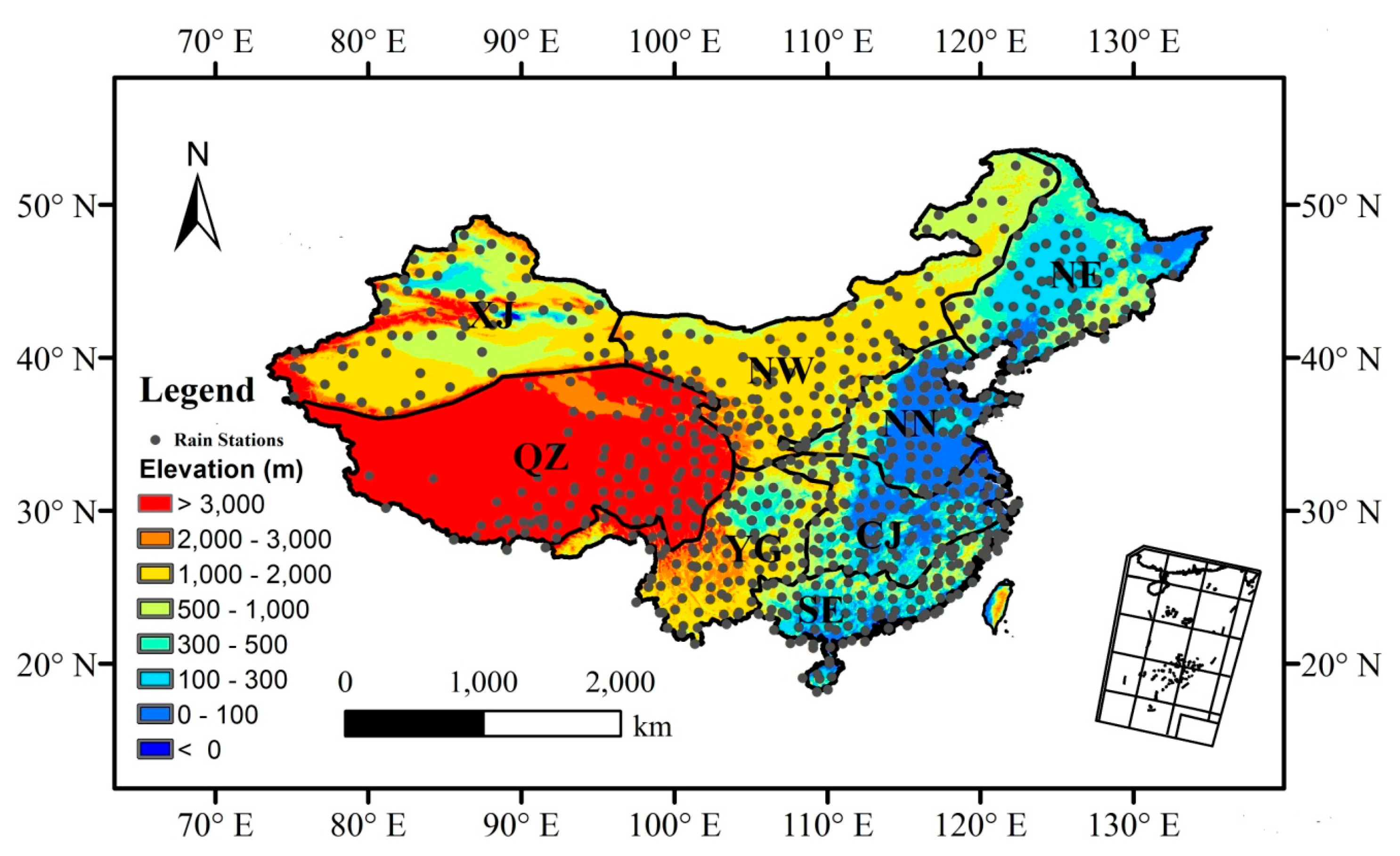


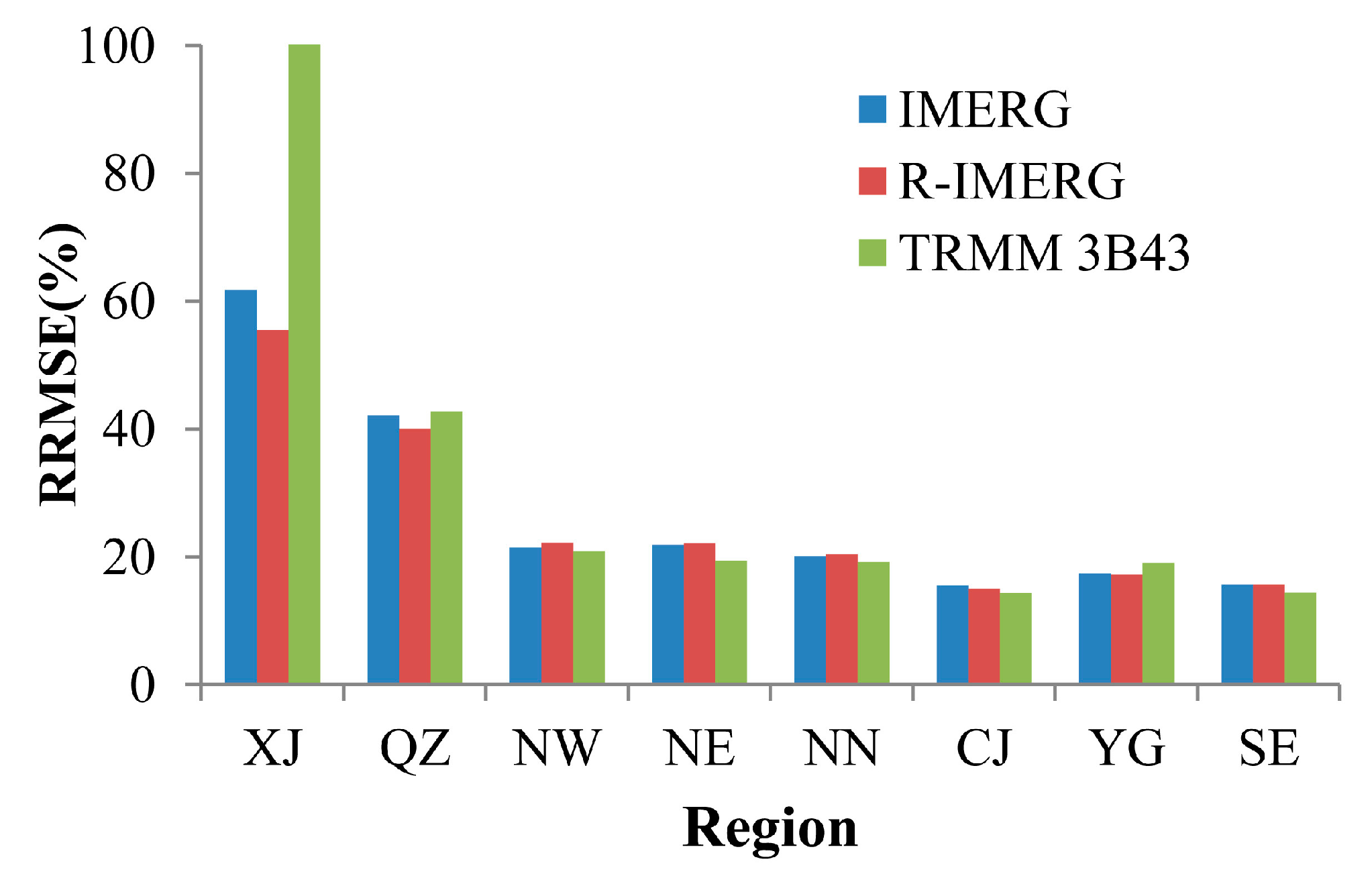
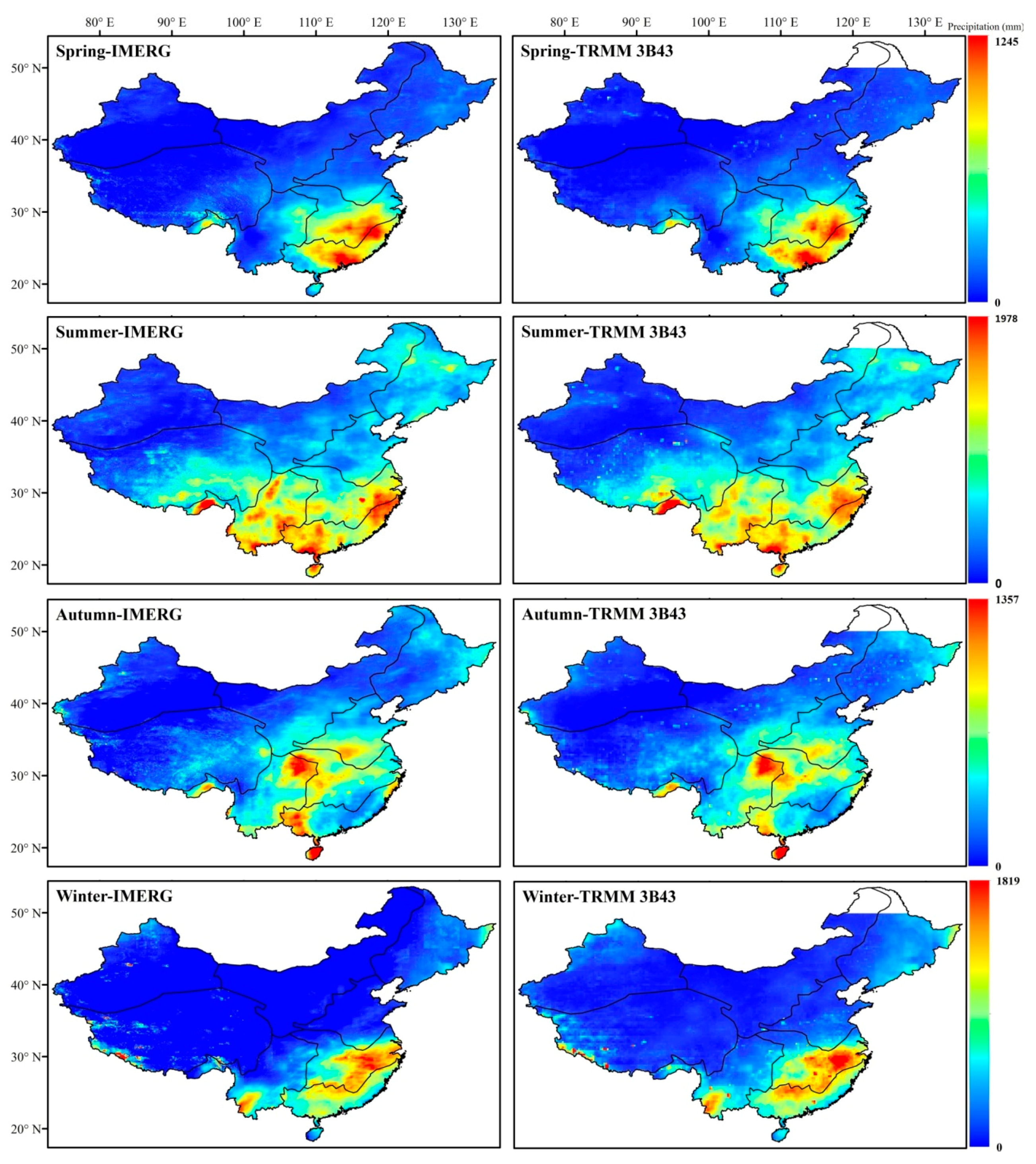
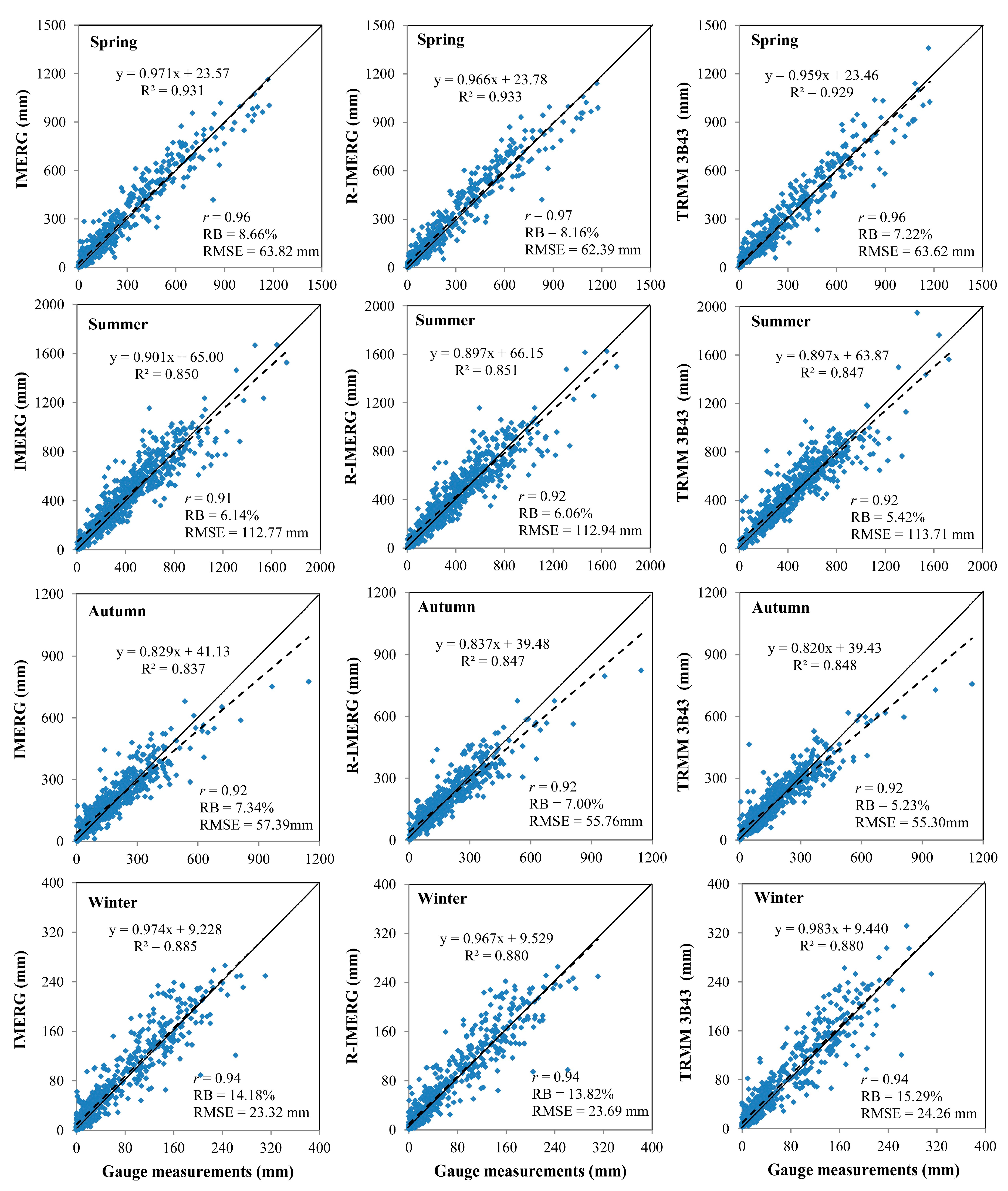
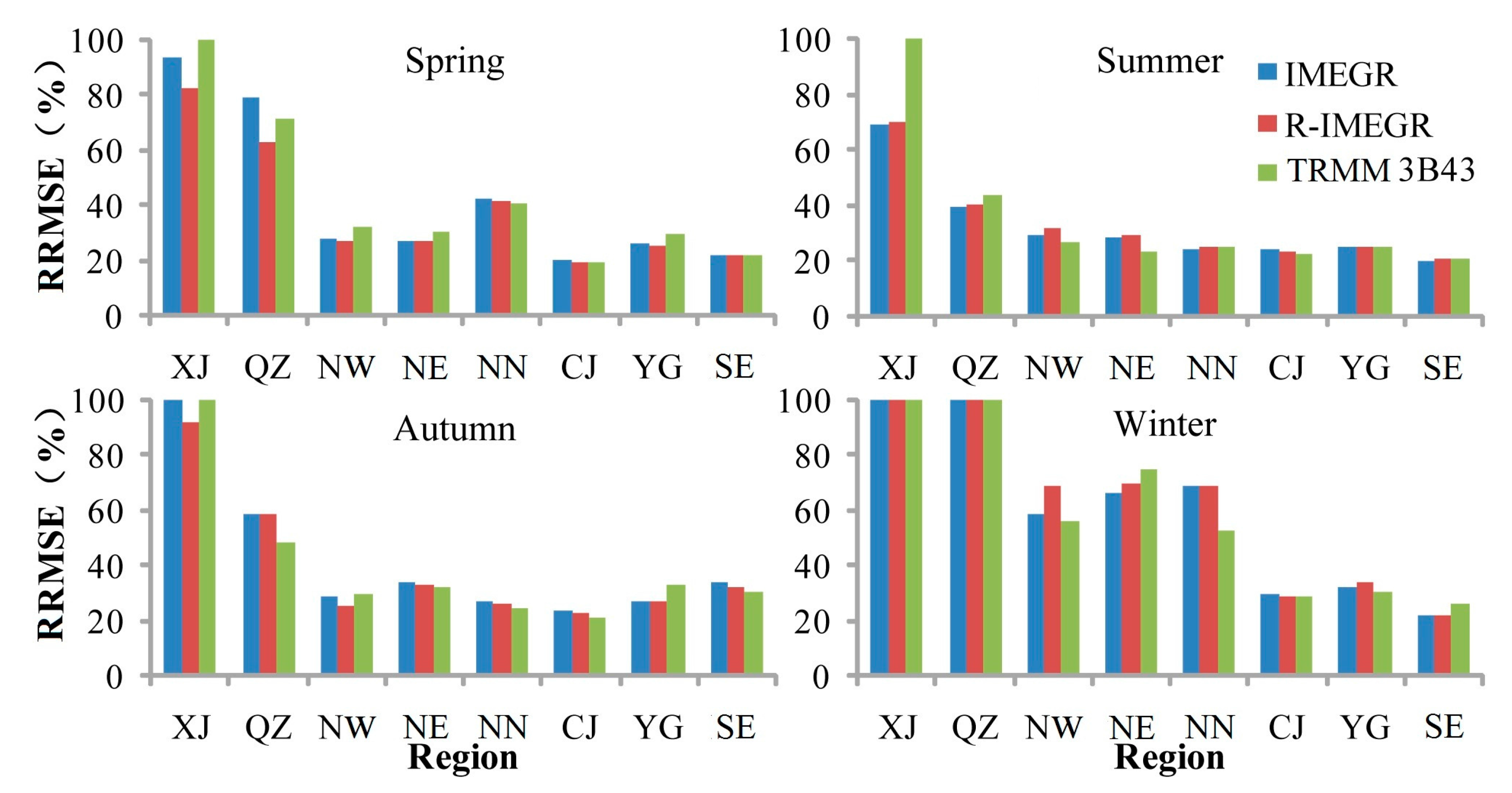
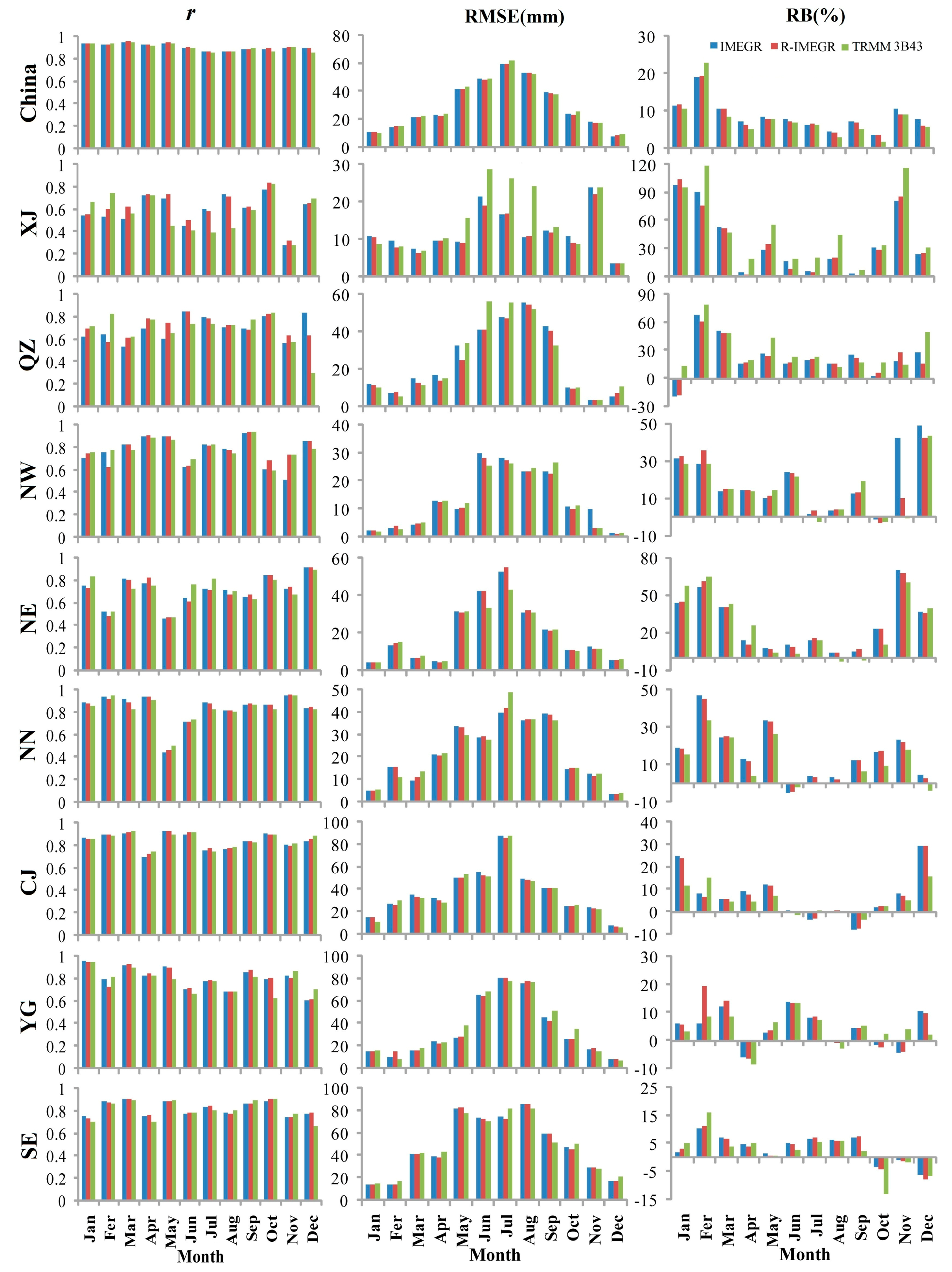
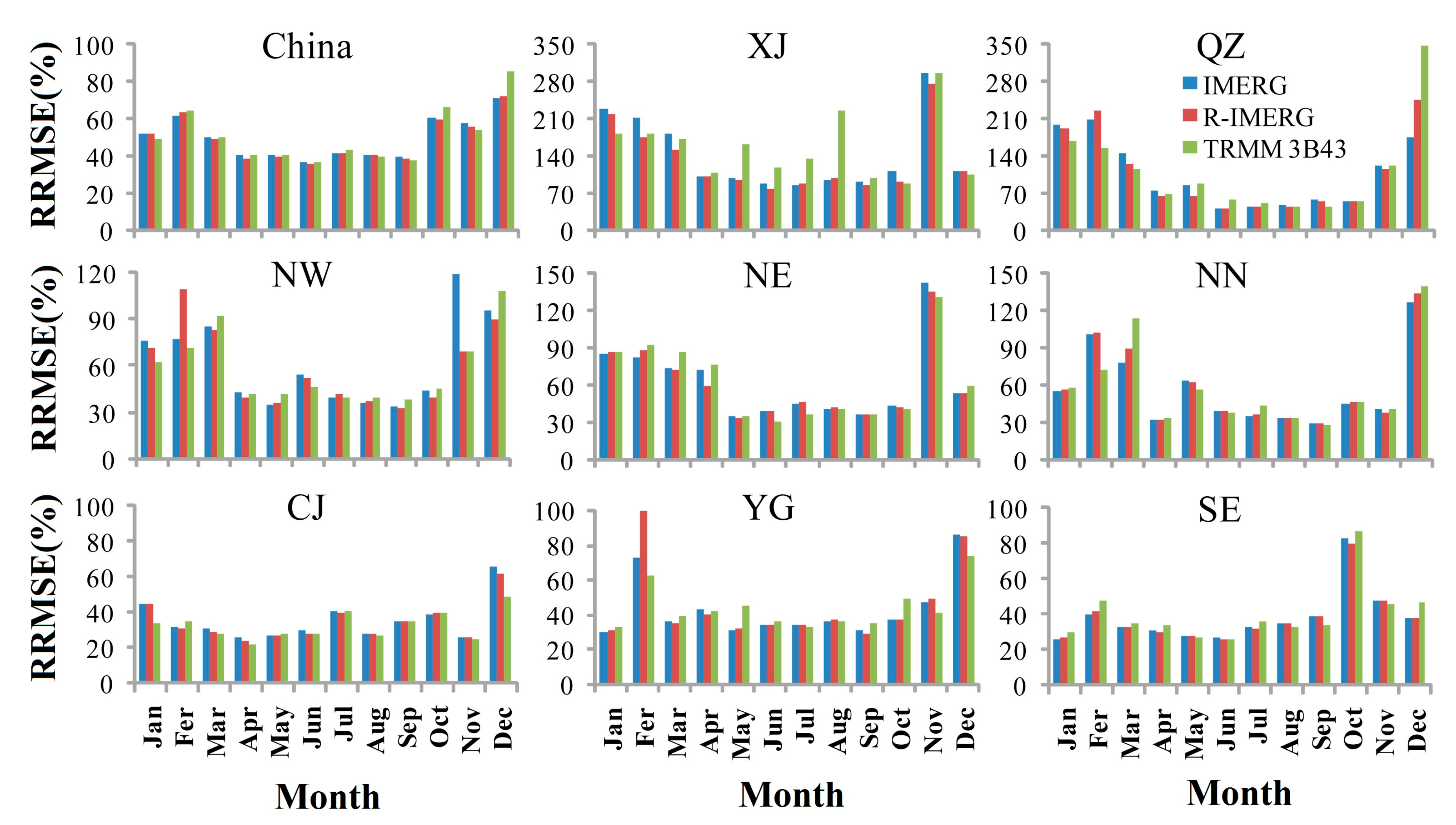
| Indexes | Time | Data | XJ | QZ | NW | NE | NN | CJ | YG | SE |
|---|---|---|---|---|---|---|---|---|---|---|
| r | Annual | IMERG | 0.74 | 0.72 | 0.92 | 0.79 | 0.92 | 0.87 | 0.82 | 0.79 |
| R-IMERG | 0.78 | 0.75 | 0.92 | 0.79 | 0.92 | 0.87 | 0.82 | 0.79 | ||
| 3B43 | 0.60 | 0.74 | 0.93 | 0.80 | 0.91 | 0.88 | 0.77 | 0.82 | ||
| Spring | IMERG | 0.70 | 0.63 | 0.92 | 0.68 | 0.89 | 0.94 | 0.92 | 0.90 | |
| R-IMERG | 0.78 | 0.76 | 0.93 | 0.66 | 0.89 | 0.94 | 0.93 | 0.90 | ||
| 3B43 | 0.65 | 0.74 | 0.90 | 0.60 | 0.86 | 0.93 | 0.89 | 0.91 | ||
| Summer | IMERG | 0.64 | 0.76 | 0.84 | 0.70 | 0.88 | 0.81 | 0.71 | 0.85 | |
| R-IMERG | 0.61 | 0.76 | 0.82 | 0.68 | 0.87 | 0.83 | 0.72 | 0.84 | ||
| 3B43 | 0.36 | 0.72 | 0.86 | 0.79 | 0.87 | 0.84 | 0.68 | 0.85 | ||
| Autumn | IMERG | 0.65 | 0.67 | 0.92 | 0.75 | 0.90 | 0.76 | 0.85 | 0.89 | |
| R-IMERG | 0.73 | 0.66 | 0.94 | 0.77 | 0.91 | 0.78 | 0.86 | 0.90 | ||
| 3B43 | 0.64 | 0.75 | 0.93 | 0.70 | 0.90 | 0.81 | 0.79 | 0.93 | ||
| Winter | IMERG | 0.61 | 0.81 | 0.79 | 0.71 | 0.92 | 0.89 | 0.91 | 0.72 | |
| R-IMERG | 0.65 | 0.73 | 0.74 | 0.68 | 0.92 | 0.89 | 0.90 | 0.71 | ||
| 3B43 | 0.76 | 0.72 | 0.77 | 0.72 | 0.92 | 0.90 | 0.91 | 0.66 | ||
| RMSE | Annual | IMERG | 75.12 | 206.49 | 78.58 | 113.93 | 130.15 | 220.03 | 200.07 | 266.94 |
| R-IMERG | 69.90 | 196.33 | 80.01 | 115.85 | 132.05 | 212.91 | 197.82 | 266.93 | ||
| 3B43 | 124.37 | 209.24 | 75.43 | 101.30 | 124.04 | 204.13 | 218.96 | 246.69 | ||
| Spring | IMERG | 21.66 | 55.31 | 18.16 | 27.52 | 53.99 | 84.94 | 48.70 | 116.72 | |
| R-IMERG | 19.08 | 43.85 | 17.64 | 27.52 | 53.29 | 81.96 | 47.29 | 117.67 | ||
| 3B43 | 27.41 | 49.71 | 21.09 | 30.97 | 51.69 | 80.70 | 55.05 | 115.39 | ||
| Summer | IMERG | 37.46 | 124.03 | 55.27 | 84.01 | 69.92 | 138.86 | 156.44 | 151.39 | |
| R-IMERG | 37.87 | 125.08 | 56.70 | 86.96 | 72.32 | 133.08 | 155.00 | 152.24 | ||
| 3B43 | 74.18 | 137.36 | 48.38 | 68.79 | 73.08 | 128.36 | 156.69 | 151.68 | ||
| Autumn | IMERG | 32.56 | 53.44 | 27.93 | 30.75 | 51.67 | 62.92 | 67.76 | 92.67 | |
| R-IMERG | 28.82 | 53.27 | 25.08 | 30.17 | 50.48 | 61.08 | 66.40 | 88.85 | ||
| 3B43 | 35.10 | 44.10 | 29.14 | 28.76 | 46.42 | 57.42 | 81.20 | 83.04 | ||
| Winter | IMERG | 19.87 | 18.55 | 4.86 | 20.02 | 18.80 | 38.46 | 22.44 | 28.48 | |
| R-IMERG | 18.54 | 20.76 | 5.52 | 21.04 | 18.71 | 37.33 | 23.54 | 29.12 | ||
| 3B43 | 17.80 | 20.98 | 4.49 | 22.58 | 14.30 | 37.76 | 20.98 | 34.54 | ||
| RB | Annual | IMERG | 25.72 | 19.77 | 10.17 | 14.78 | 10.91 | 3.48 | 4.53 | 4.24 |
| R-IMERG | 24.79 | 19.31 | 10.41 | 14.93 | 10.49 | 3.25 | 4.53 | 3.93 | ||
| 3B43 | 38.97 | 22.48 | 10.01 | 10.48 | 6.15 | 3.04 | 3.48 | 2.69 | ||
| Spring | IMERG | 19.73 | 27.25 | 12.10 | 13.03 | 22.44 | 9.52 | 2.39 | 3.52 | |
| R-IMERG | 24.54 | 25.25 | 12.78 | 11.81 | 21.80 | 8.81 | 3.25 | 2.90 | ||
| 3B43 | 39.44 | 36.68 | 13.59 | 10.74 | 14.91 | 5.62 | 2.56 | 2.36 | ||
| Summer | IMERG | 12.89 | 17.08 | 8.74 | 9.90 | 1.28 | −1.44 | 7.16 | 6.02 | |
| R-IMERG | 9.61 | 17.38 | 9.88 | 10.10 | 0.87 | −1.38 | 6.93 | 5.74 | ||
| 3B43 | 24.99 | 19.42 | 6.97 | 5.71 | −0.83 | −0.23 | 5.78 | 4.57 | ||
| Autumn | IMERG | 32.22 | 23.69 | 10.79 | 16.83 | 14.84 | 0.37 | 2.82 | 2.22 | |
| R-IMERG | 31.77 | 22.37 | 9.07 | 17.35 | 14.68 | 0.18 | 2.71 | 2.20 | ||
| 3B43 | 43.42 | 19.72 | 13.21 | 7.26 | 8.50 | 0.71 | 4.63 | 2.43 | ||
| Winter | IMERG | 75.50 | 16.90 | 32.97 | 48.32 | 33.31 | 14.77 | 7.44 | 1.24 | |
| R-IMERG | 73.00 | 12.38 | 35.58 | 50.36 | 31.96 | 13.53 | 8.14 | 1.48 | ||
| 3B43 | 86.94 | 40.87 | 30.92 | 55.27 | 23.97 | 14.21 | 4.63 | 3.99 |
© 2016 by the authors; licensee MDPI, Basel, Switzerland. This article is an open access article distributed under the terms and conditions of the Creative Commons Attribution (CC-BY) license (http://creativecommons.org/licenses/by/4.0/).
Share and Cite
Chen, F.; Li, X. Evaluation of IMERG and TRMM 3B43 Monthly Precipitation Products over Mainland China. Remote Sens. 2016, 8, 472. https://doi.org/10.3390/rs8060472
Chen F, Li X. Evaluation of IMERG and TRMM 3B43 Monthly Precipitation Products over Mainland China. Remote Sensing. 2016; 8(6):472. https://doi.org/10.3390/rs8060472
Chicago/Turabian StyleChen, Fengrui, and Xi Li. 2016. "Evaluation of IMERG and TRMM 3B43 Monthly Precipitation Products over Mainland China" Remote Sensing 8, no. 6: 472. https://doi.org/10.3390/rs8060472






